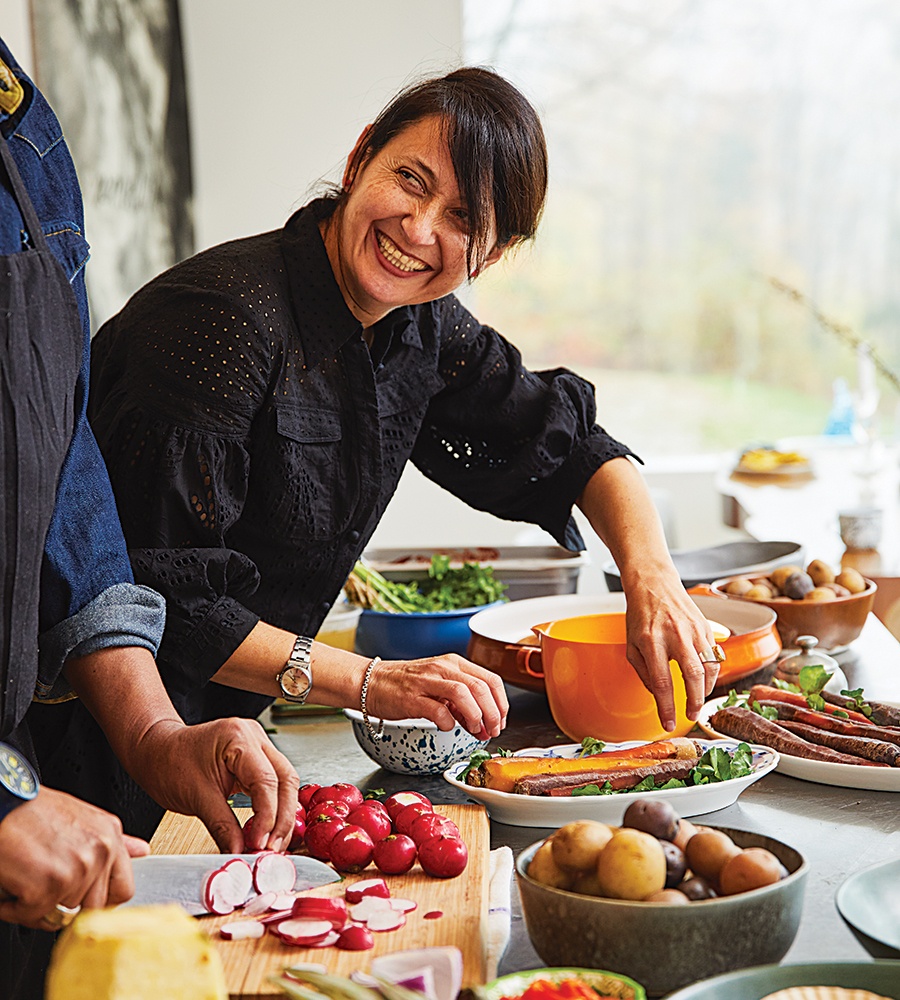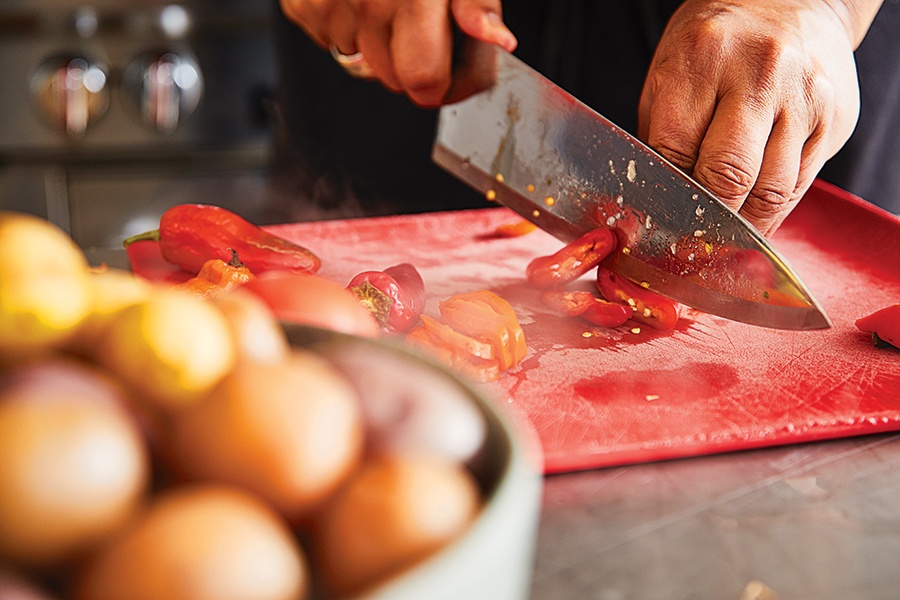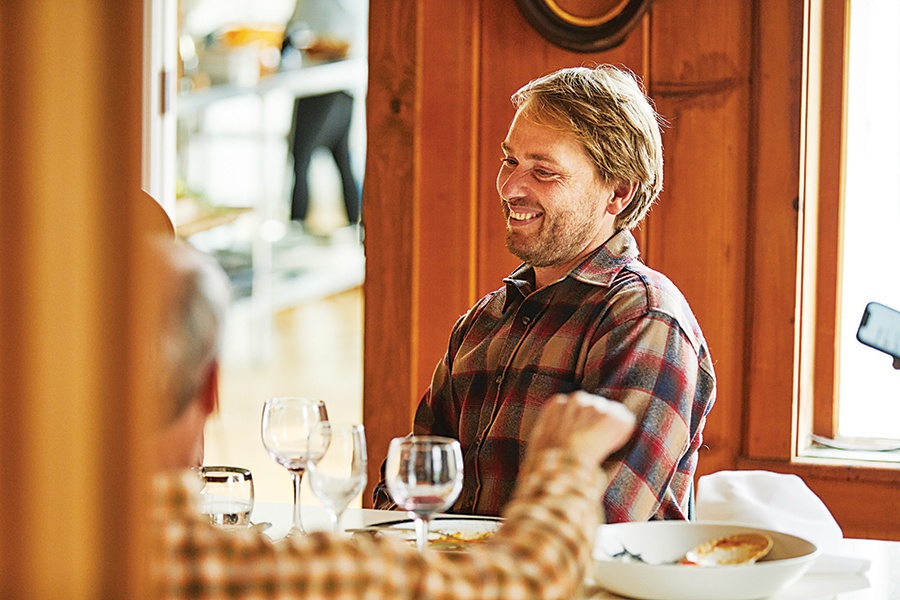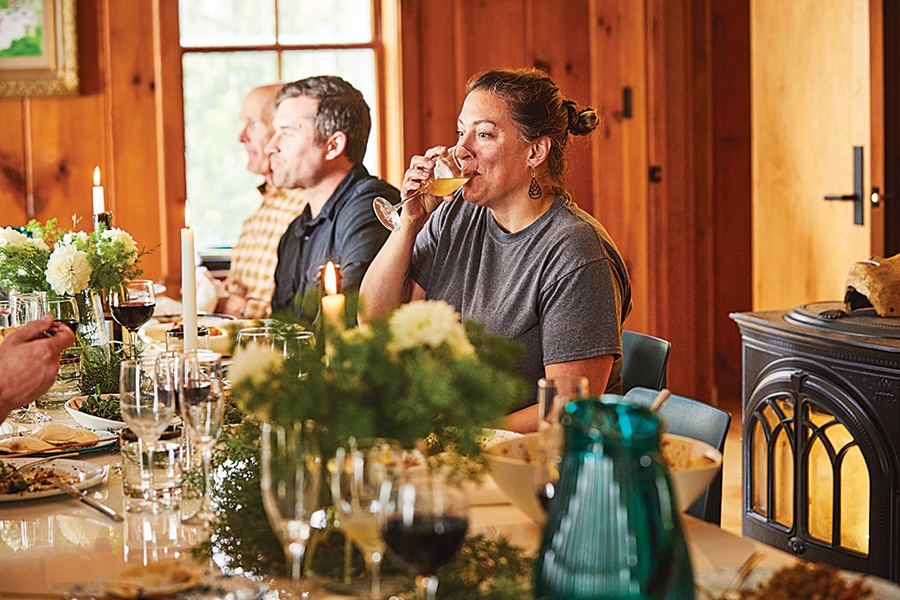A Chef’s Holiday: Recipes by Maria Rondeau and JuanMa Calderón
Right in time for the holidays, two celebrated city restaurateurs invite you to their country home in Vermont for a festive dining experience you won’t find anywhere else.
Styling by Kalei McGaw/Anchor Artists
Photographs by Pat Piasecki

Photo by Pat Piasecki
One by one, cars snake up the unpaved road to Maria Rondeau and JuanMa Calderón’s hillside home in teeny-tiny Andover, Vermont (population: fewer than 600). The 1840-built retreat has a long history of welcoming visitors—it originally operated as an inn for weary travelers. And its current owners, the twosome behind Somerville’s buzzy Peruvian restaurant Celeste, have carried on the tradition by recently transforming their rural hideaway into a unique dining destination: Esmeralda, a remote, secret-feeling supper club that serves captivating Andean cuisine and culture to in-the-know foodies willing to make the trek to the middle of not-quite-nowhere in the Green Mountain State.
Today, though, the eager (and very hungry) guests are friends of the couple, here to celebrate the upcoming winter holidays without last year’s specter of social distancing looming overhead. Merry Latin music greets them as they step inside the farmhouse-chic space, which was fully renovated by Rondeau, an architect by trade, after she and Calderón purchased the country home in 2019. Everyone hugs a tight hello and raises glasses of chicha morada, a Peruvian purple-corn drink. Then they gather, elbow to elbow, around a long table to tuck into hearty plates with soul-warming flavors: panca pepper-marinated lamb skewers; garlicky scallops au gratin served on big, fan-like shells; and pineapple baked with brown sugar and cinnamon, to name a few.

Photo by Pat Piasecki

Photo by Pat Piasecki
Not only a chance to celebrate the start of the holiday season, the dinner is also an opportunity for Rondeau and Calderón, a filmmaker and chef, to show off some of the Peruvian dishes that are destined for their next restaurant, La Royal, opening in January in Cambridge. La Royal is named for the nearby street where, prior to opening Celeste in 2018, the then-fledgling restaurateurs honed their hospitality through a series of pop-up supper clubs at their primary residence.
Esmeralda, meanwhile, is fully dedicated to the art of the dinner party, and since launching over the summer, it has already attained an air of near-myth (as well as national notice in the New York Times) for the sublime cooking and distinctive setup. There are only two dozen seats available for each meal, shared with fellow guests—strangers turned fast friends. Weather permitting, the experience might even include a traditional pachamanca, a pre-Inca-rooted feast of meats and vegetables slow-cooked with hot stones in a dirt-covered earthen oven dug into the ground.
Understandably, the warm, welcoming hosts keep things indoors when celebrating the winter holidays with pals. After dinner, everyone withdraws to the cozy, wood-paneled den for conversation, cocktails, and custardy flan prepared by Serena Fix, La Royal’s pastry chef. The room rings with happy chatter and clinking glasses of Pisco Sours. Sharing in the love-fest is Rondeau and Calderón’s affectionate little black pug, Lola, who is always the most popular party guest. “People were dying to meet again after this crazy year,” Rondeau says. And after so long apart, being able to come together anywhere—no less with great food and friends—feels like reason enough to celebrate.

Chef JuanMa Calderón prepares lamb skewers. / Photo by Pat Piasecki

Photo by Pat Piasecki

Maria Rondeau chops peppers. / Photo by Pat Piasecki
Scallop Au Gratin with Parmesan and Garlic
•••
Panca Pepper-Marinated Lamb Skewers
•••
Baked Pineapple
•••
Seared Duck Breast with Cilantro Rice
•••
Puréed Lima Beans
•••
Watercress, Rainbow Carrot and Radish Salad
•••
Creme Caramel with Poached Fruit
•••
Pisco Sour
•••
Purple-Corn Drink

Scallops au gratin, like everything else on the dinner party’s menu, will be featured at La Royal, the team’s new restaurant opening in January in Cambridge. / Photo by Pat Piasecki
Scallop Au Gratin with Parmesan and Garlic
Serves 6
- 12 four-inch natural baking shells
- 12 jumbo scallops
- ½ cup creamed garlic
- ½ cup butter
- 1 cup grated Parmesan cheese
- Olive oil
Place all shells on a sheet pan, with a scallop centered in each one. Add a dollop of butter, a teaspoon of garlic, a generous amount of Parmesan cheese, and a few drops of olive oil onto each scallop. Heat oven to 350 degrees and place scallops in oven for about 15 to 20 minutes. Increase heat to 450 degrees for another 5 minutes, or until cheese is browned.

Panca pepper-marinated lamb skewers spice up a feast for the winter holidays in the 1840-built home, a former inn that Esmeralda co-owner Maria Rondeau, an architect by trade, fully renovated with an eye for rustic-chic appointments. / Photo by Pat Piasecki
Panca Pepper-Marinated Lamb Skewers
Serves 6
- 1 lb. lamb shoulder (or portobello mushrooms, for a vegan version)
- 1 lb. red potatoes, boiled
- 1 cup anticucho marinade sauce (available at Formaggio Kitchen)
- Homemade jalapeño mayonnaise, to drizzle
For the jalapeño mayonnaise:
- 5 whole jalapeños, stemmed
- 1 cup mayonnaise
- 1 tbsp. Dijon mustard
- 1 tbsp. huacatay (black mint)
- Salt and pepper, to taste
To make the jalapeño mayonnaise, blend jalapeños, mayonnaise, mustard, and huacatay in a food processor until smooth. Cut the lamb into thin, 1-inch-by-2-inch slices. Marinate the lamb (or mushrooms) for at least an hour in the anticucho sauce. Skewer a few slices of lamb lengthwise, weaving through the meat. Cook on high heat in a cast-iron skillet or frying pan. Add boiled potatoes and char their exterior. Serve skewers on plate alongside potatoes, drizzled with jalapeño mayonnaise.
Baked Pineapple
Serves 6
- 1 large pineapple
- 2 tbsp. brown sugar
- 2 tsp. ground cinnamon
- Pepper flakes
Peel whole pineapple and sprinkle with brown sugar and cinnamon. Cover in aluminum foil and place in oven heated to 350 degrees for 1 hour. Remove from foil, cut in slices, and add pepper flakes generously.

Friends from the southern Vermont restaurant scene gather for seared duck breast with salsa criolla. / Photo by Pat Piasecki
Seared Duck Breast with Cilantro Rice
Serves 6
- 3 12-to-14-oz. duck breasts
- 3 cups jasmine rice
- 1 large red onion, finely diced
- 2 tbsp. ground garlic
- 1 tbsp. aji panca paste (Calderón recommends Costa Peruana brand, locally available at Formaggio Kitchen)
- 1 tbsp. aji amarillo paste (Calderón recommends Costa Peruana brand, locally available at Formaggio Kitchen)
- ½ tsp. turmeric
- 3 bunches cilantro
- 2 cups Guinness or other dark beer
- Olive oil
- 1 cup combined peas, carrots, corn (can be frozen)
- 1 cup water or vegetable stock
- Salt and pepper, to taste
- Homemade salsa criolla
For the salsa criolla, combine:
- 1 red onion, julienned
- 2 tbsp. cilantro, finely chopped
- ½ tomato, finely diced
- 2 tbsp. olive oil
- Juice from 1 lime
- Salt and pepper, to taste
With a sharp knife, trim all excess fat from duck breast, and gently score skin with a crisscross pattern without puncturing the meat. Cut breasts in half for a total of 6 portions. Add salt and pepper. Sear breasts on medium-high heat, about 4 to 5 minutes on skin side first until crispy, then turn for another 2 to 3 minutes. Remove excess fat as it cooks and set aside in a bowl.
In a separate large pot, heat the duck fat to prepare the aderezo, or base. When heated, add diced onion until transparent, half the ground garlic, aji panca, and aji amarillo paste. Cook over medium heat for about 4 to 5 minutes, stirring gently to avoid sticking to pot. Add turmeric and stir.
In a blender, mix together the cilantro, the beer, and a drizzle of olive oil until fully creamed. Stir the cilantro mix into the aderezo. Add water or stock. Bring to a boil and simmer for about 30 minutes, adding peas, carrots, and corn at the 20-minute mark. Prepare rice separately by starting with a drizzle of olive oil and remaining ground garlic before adding the rice. Add water and bring to boil. Lower heat and simmer for 20 to 30 minutes until tender.
Place the seared ducks into the pot, cooking for about 2 to 3 minutes per side, and remove. Add rice into cilantro mixture, stirring gently until all rice is coated evenly. Serve rice on a platter by creating a central mound and arranging duck breasts beautifully around the plate with salsa criolla at the center.

The menu also included puréed lima beans and jalapeño mayo. / Photo by Pat Piasecki
Puréed Lima Beans
Serves 6
- 1 lb. dried lima beans
- 1 large red onion, peeled
- 1 tsp. anise seeds
- ½ cup butter
- 1 cup heavy cream
- 2 garlic cloves, whole
Soak lima beans in water overnight in a bowl. Drain water, place the beans in a pot, add cold water, and bring to a boil with whole onion and anise seeds. Boil for a few minutes, then reduce heat to simmer for about an hour or until soft, adding water if necessary. When lima beans are tender, place half of them into a blender along with the whole onion, the butter, the cream, and the garlic cloves. Blend until puréed. Return to the pot with the rest of the lima beans. Mix together until fully blended.
Ensalada de Berro, Zanahoria, y Rábanos
Watercress, Rainbow Carrot and Radish Salad
Serves 6
- 1 bunch rainbow carrots, peeled
- 1 bunch watercress
- 1 bunch radishes, thinly sliced
- 1 tsp. anise seeds
- 1 tsp. brown sugar
- Homemade vinaigrette
For the Vinaigrette, combine:
- ¾ cup olive oil
- ¼ cup balsamic vinegar
- 1 tsp. maple syrup
- Salt and pepper, to taste
To make the vinaigrette, whisk all ingredients together to create a smooth emulsion.
Add anise, sugar, and carrots to a bit of water. Steam carrots until tender and let cool. Place watercress on large serving plate, lay carrots across greens, and arrange radishes around perimeter. Drizzle vinaigrette over salad before serving.

Caramel-covered flan was a sweet finish to a holiday dinner party at Esmeralda in Vermont. / Photo by Pat Piasecki
Creme Caramel with Poached Fruit
Serves 6
For the caramel:
- ½ cup sugar
- 2 tbsp. water
For the flan:
- 2 large whole eggs
- 4 large egg yolks
- ½ cup sugar
- 1 ½ cups heavy cream
- 1 cup of Perfecto Amor, Sauternes, or another dessert wine
- 1 tsp. vanilla bean paste or essence
- 6 ramekins (about 3 ¼ inches in diameter)
- Poached fruit for garnish
For the poached fruit:
- 1 ½ cups dessert wine
- ¾ cup sugar
- ¾ cup water
- 1 cinnamon stick
- 2 cardamom pods
- 1 bay leaf
- 2 cloves
- 3 black pepper corns
- 2 whole quince, apricot, pears, or prunes
To make the poached fruit, put all of the ingredients except the fruit in a saucepan and bring to a simmer. Peel and quarter the fruit, removing and reserving the cores. Add the fruit to the poaching liquid, including the peel and cores. Cover and cook in a 300-degree oven until very tender, 1 to 2 hours. Strain the poaching liquid into another pan and extract the fruit, discarding the peel, cores, and spices. Boil the poaching liquid for about 5 minutes and pour into a jar or bowl. Add the fruit. Let cool, then refrigerate until served. Note: The fruit will deepen in color over time.
To make the caramel, add sugar and water to saucepan. Swirl around until evenly distributed, and then cook the liquid until it is dark golden brown. Divide among 6 ramekins, quickly
swirling the hot caramel to cover their bases. Leave to cool and harden, about 20 minutes.
To make the flan, whisk the whole eggs, egg yolks, and sugar in a large bowl. Warm up the heavy cream in a pan, add vanilla bean paste, and leave to infuse for about 10 minutes. In a separate pan, bring the dessert wine to just below boiling and then allow to cool a little. Pour the wine gradually over the egg mixture, continuously but gently whisking, then add the cream in the same way. Strain the mixture into the ramekins. Put the ramekins into a baking pan. Add some hot (but not boiling) water to about halfway up the sides of each dish.
Bake for 25 minutes at 300 degrees. The centers should still jiggle a little; they will firm up as they cool. When cool, cover and refrigerate overnight. Remove from the refrigerator at least an hour before serving. Run a flat knife around the edges of the flan and invert ramekins onto individual serving plates, giving them a bit of a shake to ease out the flan. Garnish with a little fruit, such as quince, apricots, pears, or prunes, poached in the same wine used for the flan (or another liquor of choice), and drizzle with some of its poaching liquid.

Frothy Pisco Sours are a classic Peruvian cocktail. / Photo by Pat Piasecki
Pisco Sour
Serves 1
- 2 oz. pisco
- 1 oz. lime juice
- 1 oz. simple syrup
- 1 oz. egg white
Add ingredients to a cocktail shaker and shake without ice to create a foam. Add ice to the shaker, then shake again (about 8 to 10 times) until well-chilled. Stir and strain into a stemmed glass. Style with a couple of drops of your choice of bitters.
Purple-Corn Drink
Serves 6 to 8
- 5 to 6 purple corn cobs (Rondeau recommends Inca’s Food brand, or equivalent)
- ½ pineapple, quartered (include core)
- 2 apples, quartered
- 1 tsp. cloves
- 2 to 4 cinnamon sticks
- 4 limes, juiced
- ½ lb. panela (brown sugar cane)
- 5 liters water
In a large pot, combine water, purple corn cobs, pineapple, apples, cloves, and cinnamon. Allow to boil vigorously for 15 to 20 minutes. Reduce to a simmer for 1 hour. Add panela and simmer for additional 30 minutes. Remove from heat and allow to cool completely before draining. Add lime juice, refrigerate, and serve over ice in 16-ounce glasses.

Photo by Pat Piasecki

Photo by Pat Piasecki


